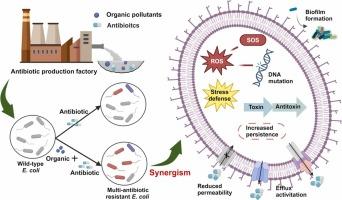Antibiotic resistance evolution driven synergistically by antibiotics and typical organic pollutants in antibiotic production wastewater
IF 12.2
1区 环境科学与生态学
Q1 ENGINEERING, ENVIRONMENTAL
引用次数: 0
Abstract
A major concern regarding the risk of antibiotic production wastewater (APW) for the transmission of antibiotic resistance (AR) stems from the residual antibiotics. However, APW also contains high concentrations of organic pollutants, many of which have severe biological toxicity and joint toxicity with antibiotics. The contribution of these organic pollutants to the development of AR in the APW treatment system is unknown. In this study, a wild-type Escherichia coli strain was exposed to six typical organic pollutants in APW individually and synergistically with the antibiotic ampicillin (AMP). Independent exposure to organic compounds had negligible effects on the evolution of AR, whereas they synergistically induced AR mutations and increased antibiotic persistence with AMP, especially the raw material d-p-hydroxyphenylglycine (DHPG), at relevant concentrations in APW. Combined exposure to 1–500 mg/L DHPG and 1 mg/L AMP synergistically increased the mutation frequencies against multiple antibiotics by up to 2928.9-fold in a dose–time pattern, and the combination index reached 445.7. Phenotypic and genotypic analyses revealed that the synergism between DHPG and AMP was associated with increased antibacterial activity, enhanced oxidative stress, and stimulation of efflux pump expression. Overall, our results highlight the elevated risk of AR induction caused by antibiotics and organic pollutants in APW.

抗生素生产废水中抗生素和典型有机污染物协同驱动的抗生素耐药性进化
抗生素生产废水(APW)传播抗生素耐药性(AR)的风险主要来自于残留的抗生素。然而,抗生素生产废水中还含有高浓度的有机污染物,其中许多都具有严重的生物毒性以及与抗生素的联合毒性。这些有机污染物对 APW 处理系统中 AR 的形成有多大影响尚不清楚。在本研究中,野生型大肠埃希氏菌株单独暴露于亚太地区污水处理系统中的六种典型有机污染物,并与抗生素氨苄西林(AMP)协同作用。单独暴露于有机化合物对 AR 的进化影响微乎其微,而在 APW 中的相关浓度下,它们与 AMP(尤其是原料 d-对羟基苯甘氨酸(DHPG))协同诱导 AR 突变并增加抗生素的持久性。在剂量-时间模式下,1-500 毫克/升 DHPG 和 1 毫克/升 AMP 的联合接触可协同增加抗多种抗生素的突变频率,最高可达 2928.9 倍,联合指数达到 445.7。表型和基因型分析表明,DHPG 和 AMP 的协同作用与抗菌活性增加、氧化应激增强和外排泵表达刺激有关。总之,我们的研究结果突显了抗生素和有机污染物在亚太水产养殖中诱导 AR 的风险升高。
本文章由计算机程序翻译,如有差异,请以英文原文为准。
求助全文
约1分钟内获得全文
求助全文
来源期刊

Journal of Hazardous Materials
工程技术-工程:环境
CiteScore
25.40
自引率
5.90%
发文量
3059
审稿时长
58 days
期刊介绍:
The Journal of Hazardous Materials serves as a global platform for promoting cutting-edge research in the field of Environmental Science and Engineering. Our publication features a wide range of articles, including full-length research papers, review articles, and perspectives, with the aim of enhancing our understanding of the dangers and risks associated with various materials concerning public health and the environment. It is important to note that the term "environmental contaminants" refers specifically to substances that pose hazardous effects through contamination, while excluding those that do not have such impacts on the environment or human health. Moreover, we emphasize the distinction between wastes and hazardous materials in order to provide further clarity on the scope of the journal. We have a keen interest in exploring specific compounds and microbial agents that have adverse effects on the environment.
 求助内容:
求助内容: 应助结果提醒方式:
应助结果提醒方式:


